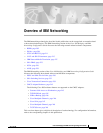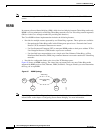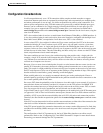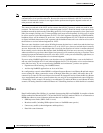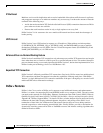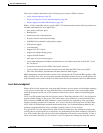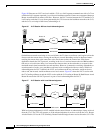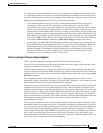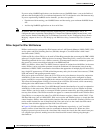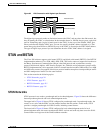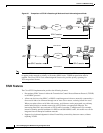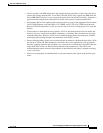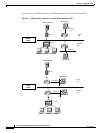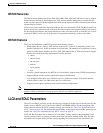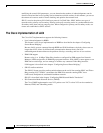
Overview of IBM Networking
DLSw+
BC-206
Cisco IOS Bridging and IBM Networking Configuration Guide
78-11737-02
IP Multicast
Multicast service avoids duplication and excessive bandwidth of broadcast traffic because it replicates
and propagates messages to its multicast members only as necessary. It reduces the amount of network
overhead in the following ways:
• Avoids the need to maintain TCP Switch-to-Switch Protocol (SSP) connections between two DLSw
peers when no circuits are available
• Ensures that each broadcast results in only a single explorer over every link
DLSw Version 2 is for customers who run a multicast IP network and do not need the advantages of
border peering.
UDP Unicast
DLSw Version 2 uses UDP unicast in response to a IP multicast. When address resolution packets
(CANUREACH_EX, NETBIOS_NQ_ex, NETBIOS_ANQ, and DATAFRAME) are sent to multiple
destinations (IP multicast service) DLSw Version 2 sends the response frames (ICANREACH_ex and
NAME_RECOGNIZED_ex) via UDP unicast.
Enhanced Peer-on-Demand Routing Feature
DLSw Version 2 establishes TCP connections only when necessary and the TCP connections are brought
down when there are no circuits to a DLSw peer for a specified amount of time. This method, known as
peer-on-demand routing, was recently introduced in DLSw Version 2, but has been implemented in Cisco
DLSw+ border peer technology since Cisco IOS Release 10.3.
Expedited TCP Connection
DLSw Version 2 efficiently establishes TCP connections. Previously, DLSw created two unidirectional
TCP connections and then disconnected one after the capabilities exchange took place. With DLSw
Version 2, a single bidirectional TCP connection establishes if the peer is brought up as a result of an IP
multicast/UDP unicast information exchange.
DLSw+ Features
DLSw+ is the Cisco version of DLSw and it supports several additional features and enhancements.
DLSw+ is a means of transporting SNA and NetBIOS traffic over a campus or WAN. The end systems
can attach to the network over Token Ring, Ethernet, Synchronous Data Link Control (SDLC) Protocol,
Qualified Logical Link Control (QLLC), or FDDI. See the DLSw+ Design and Implementation Guide
Appendix B, “DLSw+ Support Matrix,” for details. DLSw+ switches between diverse media and locally
terminates the data links, keeping acknowledgments, keepalives, and polling off the WAN. Local
termination of data links also eliminates data-link control timeouts that can occur during transient
network congestion or when rerouting around failed links. Finally, DLSw+ provides a mechanism for
dynamically searching a network for SNA or NetBIOS resources and includes caching algorithms that
minimize broadcast traffic.



